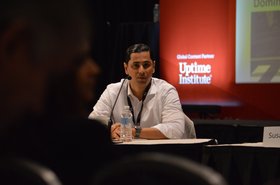"You have to fight.”
Adam Kramer is insistent. Climate change is real, and we all need to do our part.
Speaking at DCD’s San Francisco event this October, Switch’s EVP of strategy pulled no punches: “To build a credible renewable energy plan is not simply to state that we want to be 100 percent renewable by 2050, or whatever it is. It has to be better.
“I just saw one of our peers announce they’re up to 18 percent renewable energy this year,” he said. “That’s a bit unacceptable, honestly, for our industry. It shows a lack of true desire to actually become renewable.”
Switch has been fully powered by renewable energy for years, and Kramer says it had to fight to get where it has.
This feature appeared in the October Renewables Supplement. Read it for free today.
Back in 2010, local utility NV Energy used Nevada’s laws to block Switch from changing suppliers and use renewable energy from First Solar, a utility with an industrial-scale solar farm. Switch contested this in the courts of law and public opinion, eventually suing NV Energy.
Casinos, lobbyists, and politicians were dragged into the brawl, along with electric car maker and Nevada neighbor Tesla. Millions were spent on both sides for the largest ballot initiative in the state’s history, with Switch ultimately winning the right to leave the utility back in 2016.
“Sometimes it doesn’t have to be a fight with the utility - which is funny coming from Switch - but it also can be a partnership,” Kramer said. “We worked very closely with Georgia Power on getting renewable energy tariffs, working with the utility to bring on more renewable energy that’s locally produced.”
Over in Michigan, where the company now plans to build a huge campus with 1.8 million square feet of white space and 320MW of IT power, Kramer says that Switch was willing to risk the project for renewable energy.
“We worked with [the local utility] and told them we wouldn’t even come if they wouldn’t build this, and we worked with political leaders, and we invested the money and the time to make that happen.”
When it sources renewable energy Switch now demands that energy is newly added to the grid, instead of using simple credits to consume existing capacity. Where possible, it also seeks renewable power generation projects that are close to its data centers, keeping the carbon reduction within the community.
Over in Tahoe, the company plans to take this philosophy to the extreme. The campus eventually hopes to grow to over 10 million square feet of data center space, requiring colossal quantities of power.
“Just to the east of us, we are building the largest behind-the-meter [onsite] solar plus storage project in the world. That’s 100MW of solar and 240 megawatt-hours of energy storage,” Kramer said.
“We’re building a micro grid system that is both behind the meter, but also interconnected into the grid, so we can pull any additional resources we need from the grid, or maybe sell back excess energy if there is any.”
The project, which uses First Solar panels and Tesla Megapack storage, is funded by Capital Dynamics, requiring no up-front investment from Switch. It is also planning two other similar projects across Nevada, for a total of 555MW of power generation and 800 megawatt-hours of battery storage.
“We have availability of land [by the data center campus], so we can triple the size of our project and go to 300MW of energy behind the meter. And we can do as much energy storage as we see fit, just because it really is a small footprint for those megawatt-hours of storage.”
Such proximity to the renewable power source is not something every data center can take advantage of, of course.
“What we can do for a new 100MW greenfield data center in Virginia is very different than what we might do for a multi-story, urban data center in Singapore,” Digital Realty’s director of sustainability programs Aaron Binkley said.
“What options are available just within that state or country can vary significantly - and you multiply that by 280+ data centers around the world and 45 metros, you can see how we need to have consistent themes and approaches but have a lot of ability to tailor and suit solutions to those individual circumstances.”
On-site solar is a problem where space is tight, for instance. “For a typical greenfield data center, we can cover the entire roof with solar panels, and only offset about half of one percent of that building’s energy load,” Binkley said. Adjacent land is expensive - it’s land able to support data centers - “so that quickly shifts us to looking at off-site utility-scale renewable solutions.
“And that’s simply to address the scale of the loads at a given site, but also to address the realities that there are just some things you can’t do on the site, given the densities that we need to hit, to make to make those developments profitable.”
Both companies have seen customers demand a more aggressive approach to renewable energy commitments. Hyperscalers in particular already mostly demand 100 percent renewable energy.
Increasingly, smaller customers are asking about it too, but it’s still not at the top of everyone’s agenda. “We’ve got 4,000+ customers around the world,” Binkley said. “For many customers, it’s not even on the radar,” he admitted. “For some, it might be on the radar, but they’re silent to us about it. And others are aggressively pursuing us to find solutions and collaborate with them. And we have to address that whole spectrum from a customer expectation standpoint.”
Often a company’s public pronouncements don’t line up with the reality of what it contracts, Binkley revealed. “The amount of times we see a corporate commitment from a business around renewables and then we see absolutely nothing at all about it in an RFP for data center space is pretty common.”
For many of Digital’s data centers, the company offers renewable energy via PPAs, if customers ask for it. “And we would love to compete with all of our peers to provide the best data center solution with the most renewables,” Binkley said. “If that’s a requirement of an RFP, let’s put everybody on a level playing field and let’s see who’s got the best solution.”
For that to happen at a greater scale requires users to be more proactive in demanding renewable energy, Binkley argued. “We’re kind of looking to the marketplace of users to make it a requirement, and put screws to the industry.”
But for Kramer - who was keen to note that “Digital Realty has done a really good job” with its sustainability efforts - data center companies need to become more proactive in making the world’s energy grids transition to renewable sources.
“I think that many of our peers have allowed the lack of availability of green energy tariffs, or sometimes the cost of it, to stop them from actually procuring it, without realizing that with a little more work and digging a little bit deeper, you can procure renewable energy and actually reduce your energy costs,” he said.
“If renewable energy isn’t available on your local system, right now, you can work with each other, you can work with politicians,” Kramer continued.
“But you have to be willing to do the work, you have to be willing to engage - there is still not an easy button in most of these places to get renewable energy. You have to do the work.”





